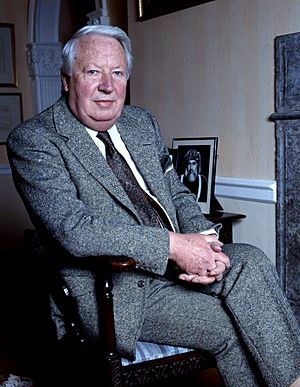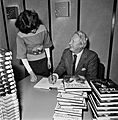Edward Heath facts for kids
Quick facts for kids
Sir Edward Heath
|
|
|---|---|

Heath in 1987 by Allan Warren
|
|
| Prime Minister of the United Kingdom | |
| In office 19 June 1970 – 4 March 1974 |
|
| Monarch | Elizabeth II |
| Preceded by | Harold Wilson |
| Succeeded by | Harold Wilson |
| Leader of the Opposition | |
| In office 4 March 1974 – 11 February 1975 |
|
| Monarch | Elizabeth II |
| Prime Minister | Harold Wilson |
| Preceded by | Harold Wilson |
| Succeeded by | Margaret Thatcher |
| In office 28 July 1965 – 19 June 1970 |
|
| Monarch | Elizabeth II |
| Prime Minister | Harold Wilson |
| Preceded by | Sir Alec Douglas-Home |
| Succeeded by | Harold Wilson |
| Leader of the Conservative Party | |
| In office 28 July 1965 – 11 February 1975 |
|
| Preceded by | Sir Alec Douglas-Home |
| Succeeded by | Margaret Thatcher |
| Member of Parliament for Old Bexley and Sidcup (n.b.) |
|
| In office 23 February 1950 – 14 May 2001 |
|
| Personal details | |
| Born |
Edward Richard George Heath
9 July 1916 Broadstairs, Kent, England |
| Died | 17 July 2005 (aged 89) Salisbury, Wiltshire, England |
| Resting place | Salisbury Cathedral |
| Political party | Conservative |
| Alma mater | Balliol College, Oxford |
| Occupation |
|
| Military career | |
| Service/ |
|
| Rank | Lieutenant colonel |
| Service number | 179215 |
| Battles/wars | World War II |
| n.b. | |
Sir Edward Richard George Heath (9 July 1916 – 17 July 2005), often called Ted Heath, was a British Conservative politician. He served as the Prime Minister of the United Kingdom from 1970 to 1974. Heath was also the leader of the Conservative Party from 1965 to 1975.
He studied at Balliol College, Oxford. As a student, he traveled to Nuremberg, Germany, in 1937. There, he met some top Nazi leaders, including Heinrich Himmler, whom he described as the most evil person he had ever met. Heath also visited Barcelona, Spain, in 1938 during the Spanish Civil War. He returned to Germany in 1939 before World War II began.
Edward Heath was a talented classical organist and conductor. He was also a keen sailor. He never married.
Contents
Early Life and Education
Edward Heath came from a working class family. His father was a carpenter and his mother was a maid. He was one of the first British prime ministers after World War II to come from a more humble background.
Heath attended a grammar school in Ramsgate. He won a special scholarship to study at Balliol College, Oxford. He was a very good musician and won an organ scholarship in his first term. This allowed him to stay at the university for an extra year. He finished his studies in philosophy, politics, and economics in 1939.
Military Service in World War II
Heath joined the army during World War II. He started as a second lieutenant in the Royal Artillery. In 1944, he took part in the Normandy Landings, a very important event in the war. He left the army in 1947 as a lieutenant-colonel.
After working in the Civil Service for a short time, Heath became a Member of Parliament (MP) for Bexley. He won this seat in the February 1950 general election.
Political Career Highlights
Heath quickly moved up in the Conservative Party. He served as a "whip," which is a role that helps manage party members in Parliament. He became the Chief Whip and Parliamentary Secretary to the Treasury from 1955 to 1959. In 1959, he became the Minister of Labour, a senior government job.
In 1960, Prime Minister Harold Macmillan asked Heath to lead talks for the UK to join the European Economic Community (EEC). This was a group of European countries working together, now known as the European Union. After long discussions, France's President, Charles de Gaulle, stopped Britain from joining.
From 1965 to 1970, Heath was the Leader of the Opposition. This meant he led the main party not in power. In the General Election of 1970, his party won, and he became Prime Minister.
During his time as Prime Minister, the UK government made some big changes.
Changing Money and Measurements
For a very long time, the UK's money system was based on 240 pence to one pound. On 15 February 1971, called Decimal Day, the UK changed to a decimal currency. This meant 100 pence made one pound, just like most other countries.
This was a huge change for everyone. All the money in shops and banks had to be replaced. Many machines, like cash registers, also needed to be updated.
Around the same time, the UK also started to change from its old imperial system of weights and measures (like pounds and inches) to the metric system. This change was not fully finished. For example, speed limits are still in miles per hour. This change was mainly because joining the European Economic Community (EEC) meant the UK had to use the metric system for many things.
Joining Europe
Heath was determined for the UK to join the European Economic Community (EEC). After Charles de Gaulle left office, Britain's chance came. The EEC's economy was also slowing down, and British membership was seen as a way to help it. After a long meeting between Heath and French President Georges Pompidou, Britain's third attempt to join was successful. The UK officially joined the EEC in 1973 with the European Communities Act 1972.
End of His Time as Prime Minister
Heath faced challenges with powerful unions. Two miners' strikes caused problems for the economy. The strike in 1974 was so serious that many businesses had to work only three days a week to save energy.
This situation led to a general election in 1974. Heath's government lost the election. This ended his time as Prime Minister. The Conservative Party later chose Margaret Thatcher to replace him as their leader.
Images for kids
-
Heath with US president Richard Nixon at the White House in 1973
-
Heath greeting US president Gerald Ford in September 1974
-
Heath's monument in Salisbury Cathedral
See Also
 In Spanish: Edward Heath para niños
In Spanish: Edward Heath para niños










